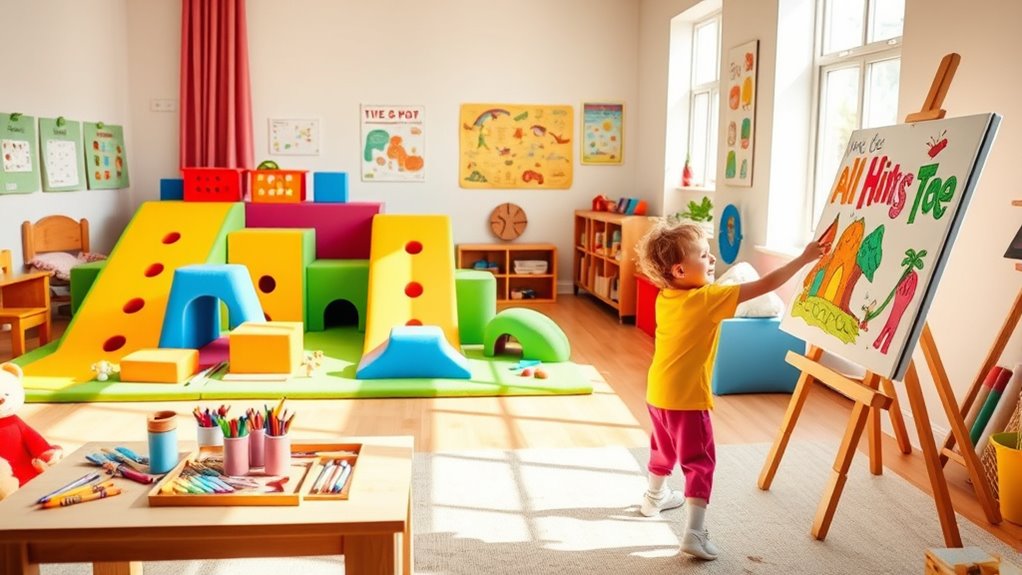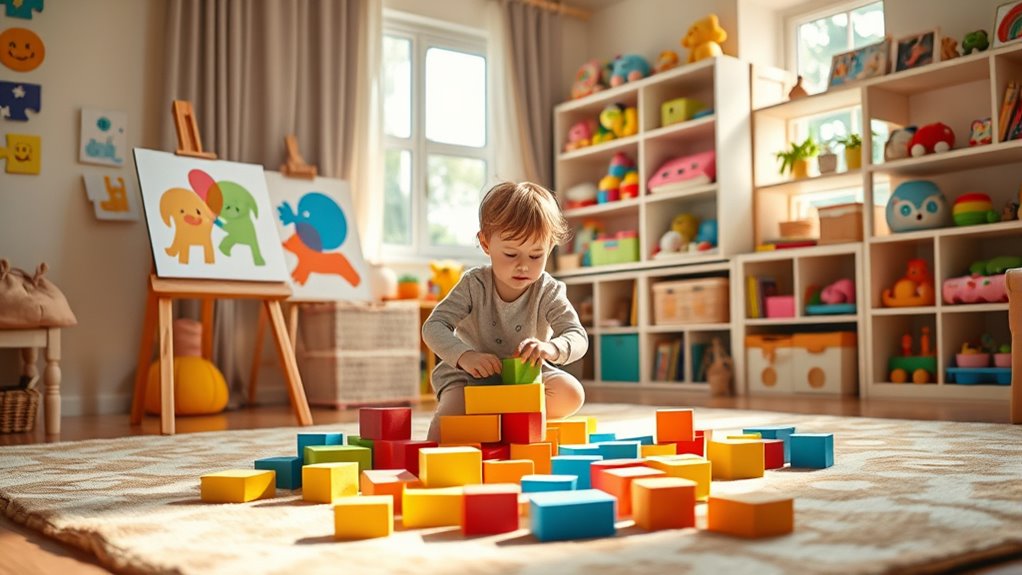To boost your child’s development through creative play, encourage imaginative storytelling by asking open-ended questions and adding twists, which build critical thinking, language skills, and empathy. Incorporate sensory activities like textured bins, playdough, or role-play with costumes to stimulate their senses and enhance motor skills. Stay flexible and responsive, expanding on their ideas to foster confidence and curiosity. Keep exploring these fun strategies, and you’ll discover more ways to nurture your child’s growth beyond imagination.
Key Takeaways
- Incorporate imaginative storytelling activities that encourage your child to create and expand stories, boosting language and critical thinking skills.
- Use sensory exploration activities like sensory bins and textured materials to enhance cognitive development and fine motor skills.
- Combine storytelling with sensory play by creating themed environments, such as enchanted forests or tactile adventure zones.
- Encourage collaborative and flexible play, allowing your child’s curiosity and ideas to guide activities and foster confidence.
- Use props, costumes, and role-playing to make stories immersive, promoting emotional understanding and social skills development.

Are you looking for fun ways to spark your child’s imagination and keep them engaged? One of the most effective methods is through imaginative storytelling. When you encourage your child to create their own stories, you’re helping them develop critical thinking, language skills, and emotional understanding. Start by asking open-ended questions about their favorite characters or adventures, then let their imagination take over. You can join in by adding your own twists or characters to the story, making it a collaborative experience. This not only boosts their creativity but also helps them build confidence as they see their ideas come to life. Imaginative storytelling also fosters empathy, as they learn to see the world from different perspectives through their stories.
Alongside storytelling, sensory exploration offers another fantastic way to engage your child’s mind and senses. Set up activities that allow them to explore different textures, smells, sounds, and visuals. For example, create a sensory bin filled with rice, beans, or pasta, and hide small toys or objects inside for them to find. As they dig through, they’re practicing fine motor skills and sensory discrimination. You could also introduce different materials like playdough, slime, or fabric swatches, encouraging your child to touch, squeeze, and manipulate them. These activities stimulate their senses and help develop their cognitive and motor skills in a fun, hands-on way.
Combining imaginative storytelling with sensory exploration creates a powerful play experience. Imagine telling a story about an enchanted forest while your child explores textured leaves, soft moss, or rough bark in a sensory garden. This approach makes the story more immersive and memorable. You can also incorporate role-play, where your child acts out parts of the story using costumes or props, further engaging their senses and imagination. These activities promote language development, problem-solving, and emotional regulation, all while keeping playtime exciting.
The key is to keep the activities flexible and responsive to your child’s interests. Let their curiosity lead the way, and be ready to adapt or expand on their ideas. Whether you’re encouraging them to craft their own tales or explore new textures, you’re supporting their overall growth and development. With a little creativity and enthusiasm, these play ideas will turn ordinary moments into valuable learning experiences, helping your child blossom into a confident, imaginative, and sensory-aware individual.
Frequently Asked Questions
How Can I Encourage Shy Children to Participate in Creative Play?
To encourage shy children to participate in creative play, start with gentle group activities that suit their comfort level. Offer lots of positive reinforcement and create a supportive environment where they feel safe to express themselves. Focus on confidence building by giving them small roles or tasks, which can help them gradually join in. Over time, they’ll feel more secure and enthusiastic to engage in creative play alongside others.
What Safety Precautions Should I Take During Messy Play Activities?
Imagine you’re a knight preparing for battle—safety first! During messy play, always use protective gear like aprons, gloves, and goggles to shield your child. Establish clear cleanup routines beforehand to make the process smooth and safe. Keep the area well-ventilated, and supervise closely to prevent ingestion or accidents. These precautions guarantee your child enjoys creative messes while staying safe and minimizing cleanup stress afterward.
How Much Time Should Children Spend on Creative Play Daily?
You should aim for about one to two hours of creative play daily, depending on your child’s age and attention span. The ideal play duration balances activity frequency and rest, encouraging your child’s imagination and skills without overexertion. Incorporate various activities throughout the day to keep play engaging and developmentally beneficial. Remember, consistent, quality playtime fosters growth, creativity, and emotional well-being.
Are There Specific Play Ideas Suitable for Children With Developmental Delays?
You’ll find that certain play ideas work well for children with developmental delays, especially those focusing on sensory integration and motor skills. Activities like textured obstacle courses, water play, or finger painting can stimulate senses and improve coordination. These tailored options help your child develop at their own pace, making play both fun and beneficial. Always observe their responses and adapt activities to suit their individual needs.
How Can I Adapt Creative Activities for Different Age Groups?
Imagine you’re a Renaissance artist, tailoring your masterpiece for each viewer. When adapting creative activities for different age groups, you focus on age-specific adaptations and developmental considerations. You simplify tasks or introduce new tools for younger children, while offering more complex challenges for older ones. This approach guarantees every child stays engaged and benefits from play, fostering growth at their unique pace. Your thoughtful adjustments make all the difference in nurturing development through creative fun.
Conclusion
By embracing these creative play ideas, you’re planting seeds of imagination and confidence in your child’s heart. Each activity is like a colorful brushstroke on their life’s canvas, building a vibrant masterpiece of growth. As they explore and create, they’re forging a path filled with endless possibilities, like a shining star guiding their way. Remember, your encouragement is the gentle breeze that helps their dreams take flight, illuminating their journey with joy and discovery.









